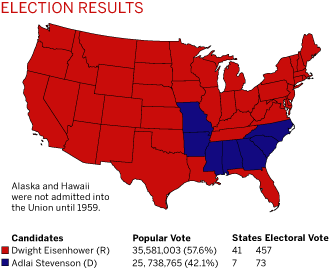For President Eisenhower, the only true emergency of his first term was the heart attack he suffered in September 1955. After his doctor pronounced him fully recovered in February 1956, Eisenhower announced his decision to run for re-election. The Democrats set up a replay of the 1952 contest by nominating Adlai Stevenson. The result was an even greater Republican landslide. Eisenhower was a popular incumbent president who had ended the Korean War. Two world crises helped cement his lead in the final days of the campaign: the Soviet Union invaded Hungary, and Britain, France, and Israel attacked Egypt in an effort to take over the Suez Canal. Eisenhower kept the United States out of both conflicts. As is traditional during a military crisis, American voters rallied behind their president. The events also undermined two of Stevenson’s key positions: the suspension of hydrogen-bomb testing and the elimination of the military draft.
Republican
Dwight D. Eisenhower for president
Richard Nixon for vice president
"Peace, Prosperity, and Progress"
Although Eisenhower was the incumbent president, his 1956 ads continued to portray him as an ordinary American. Capitalizing on his enormous popularity, they emphasized Ike’s personality even more than his accomplishments.
To counter Stevenson’s claim that the Democratic party was the party of the average American and the Republican "the party of the few," Eisenhower’s ads offered the testimony of ordinary citizens, whether in the dramatized ad "Taxi Driver and Dog" or the documentary-style "Women Voters." The latter ad was also an acknowledgment that women were crucial to Eisenhower’s 1952 landslide, supporting him by a greater margin than men.
The Eisenhower ads closed with an appeal to "all thinking voters" because a Republican victory was only possible with the support of Democrats and independents, who outnumbered Republicans in the general population. Conversely, Stevenson’s ads urged voters to uphold party loyalty, a common plea by Democratic candidates trailing in the polls.
Democrat
Adlai Stevenson for president
Estes Kefauver for vice president
"Vote Democratic, the Party for You, and Not Just a Few"
In 1956, Adlai Stevenson was still publicly railing against the expanding role of television in politics. Yet Stevenson knew that he couldn’t compete without television, and the Democratic National Committee tried to hire one of the leading Madison Avenue agencies to handle the campaign. The account was turned down by all of the large firms, who feared offending their big-business Republican clients, and was finally accepted by Norman, Craig and Kummel, an agency with little political experience that ranked 25th in billings.
The main innovation in the commercials of the 1956 campaign was the five-minute spot. Stevenson appeared in a series of such spots, titled "The Man From Libertyville," which were filmed at his home in Libertyville, Illinois. The informal and folksy ads were designed to combat Stevenson’s image as an aloof "egghead." In an attempt to portray the divorced Stevenson as a family man, some of the ads featured his son and daughter-in-law. Meanwhile, the Eisenhower campaign made frequent use of the president's Mamie and large extended family. Emanating from America’s heartland, Stevenson's Libertyville spots were designed to re-establish the Democratic party as the true voice of the American people.
The five-minute spot (actually four minutes and twenty seconds) resulted from cooperation between the networks and the candidates. Hoping to avoid the pre-emption of programs by half-hour speeches, the networks agreed to trim their shows to accommodate five-minute ads. To the candidates’ advantage, the spots were less expensive than half-hour broadcasts, and, as they could be sandwiched between popular programs, were likely to reach more viewers.
